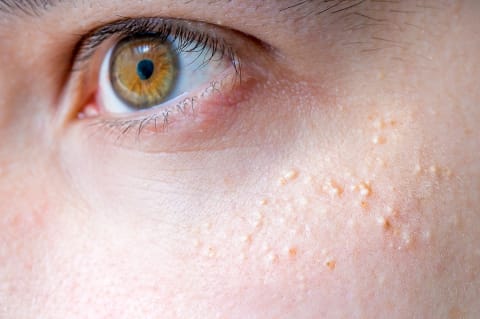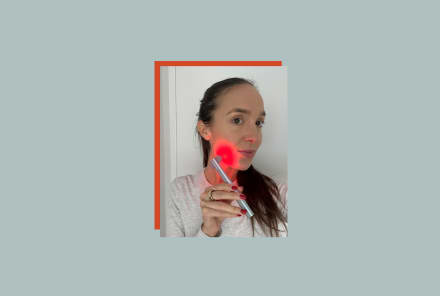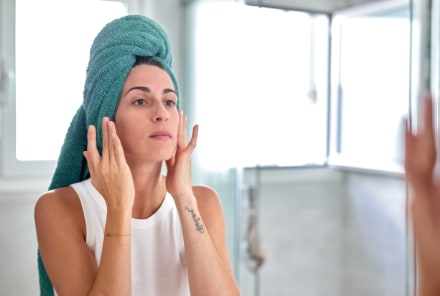Advertisement
An All-Inclusive Guide To Understanding Milia: Causes, Treatments & More

If you've ever glanced in the mirror and spotted a cluster of tiny white bumps on your face, chances are you considered them whiteheads, applied a spot treatment, and went on with your day. But if time and time again those stubborn little spots aren't going away, you may be dealing with a skin condition called milia.
Milia, aka milk spots, are itty-bitty white or yellow bumps on the surface of the skin. While they may look like little acne breakouts, they're not and shouldn't be treated the same. Milia are actually cysts filled with keratin under the skin and are most commonly found on the face above the cheekbones and under the eyes. Ahead, we tapped three dermatologists to learn what milia actually is, why you get it, and how to treat it for good.
What is milia?
Unlike acne, milia are not caused by an infection in the pore. According to Elena Villanueva, D.C., founder of Modern Holistic Health, milia is actually a buildup of keratin that gets trapped beneath the surface of the skin. It's also important to know that, unlike acne, milia does not get inflamed, red, or swollen. And you don't have to have acne-prone skin to develop milia. In fact, any skin type, gender, or age group can develop milia.
What causes them?
Causes of milia can differ, but the general cause of development is a lack of natural exfoliation of the skin. Dual board-certified dermatologist Keira Barr, M.D., explains that when dead skin cells, which are made of keratin, buildup on the surface of the skin, cysts form. One common cause of this keratin buildup is the use of heavy creams or oils on the skin, specifically around the eyes and lips.
Villanueva says it can also be caused by a lack of sleep, smoking, and poor personal hygiene habits. But chances are if you've developed milia, checking your skin care products for heavy ingredients that tend to clog pores is a wise first step.
Who gets them?

Even though milia is often associated with newborns, children and adults can develop it, too. Gender and ethnicity aren't a concern here, but skin type can matter sometimes. "Milia can happen to just about anyone, but are more prevalent in those with chronically sun-damaged skin," says Barr. She also says that those who suffer from acquitted or genetic skin conditions associated with blistering like epidermolysis bullosa may be at higher risk of developing milk spots.
If you don't fall into either of those categories, but still develop milia, it may be due to a lack of hydration in the skin. Villanueva warns that dry skin doesn't exfoliate adequately and can tend to be more prone to developing milia.
Can you prevent them?
The answer to this question is not as easy as we'd hope. As with most common skin conditions, carefully choosing skin care products can make a huge difference in the appearance of your skin. If heavy moisturizers are the cause of your milia, swap your typical formula for a lighter one, preferably not oil-based. And if eye makeup is your go-to, avoid oil-based makeup removers as they tend to leave an oily film that can clog pores. For those with dry skin, try incorporating exfoliation into your weekly skin care routine to avoid dead skin buildup. And in more serious cases of dry skin, visit an aesthetician for routine peels or microdermabrasion to exfoliate skin properly.
How do you treat it?
There are various ways you can treat milia. For an at-home option, Barr suggests reaching for topical products that include gentle exfoliants like salicylic and glycolic acids or chemical peels. But do only use gentle options; anything too aggressive can lead to skin trauma, which will only make matters worse.
"It's not recommended to remove milia at home," Villanueva suggests. "They aren't easy to remove and can easily cause damage to your skin." And no, don't try to pop them. As always, that's a big no-no. Not only will you not have success (remember, this isn't a whitehead), but you can cause further damage and irritation.
In fact, Barr and Villanueva agree the best and safest option is to visit your dermatologist for an extraction. The procedure itself is pretty simple and practically pain-free. But do know that the deeper the cyst is, the larger the incision. Barr also suggests allowing your milia to resolve on their own. "The truth is that you don't need to treat unless they are a cause for concern," she suggests. "They typically resolve on their own over time." Bottom line: The choice is up to you. But whatever you do, don't try to pop or remove them at-home.
The takeaway.
Skin conditions can actually be very tricky to identify, and milia is a great example of that. While you might think of them as whiteheads or clogged pores, they are actually keratin buildup (read: an entirely different type of buildup.) Reach for an exfoliator if you have them, but don't pick, please.
Watch Next
Enjoy some of our favorite clips from classes
Enjoy some of our favorite clips from classes
What Is Meditation?
Mindfulness/Spirituality | Light Watkins
Box Breathing
Mindfulness/Spirituality | Gwen Dittmar
What Breathwork Can Address
Mindfulness/Spirituality | Gwen Dittmar
The 8 Limbs of Yoga - What is Asana?
Yoga | Caley Alyssa
Two Standing Postures to Open Up Tight Hips
Yoga | Caley Alyssa
How Plants Can Optimize Athletic Performance
Nutrition | Rich Roll
What to Eat Before a Workout
Nutrition | Rich Roll
How Ayurveda Helps Us Navigate Modern Life
Nutrition | Sahara Rose
Messages About Love & Relationships
Love & Relationships | Esther Perel
Love Languages
Love & Relationships | Esther Perel

















